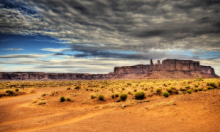Article
An arid environment characterized by limited rainfall, sparse vegetation, and animals that are specially adapted for extreme temperature changes. In the U.S. Southwest there are three deserts: the Chihuahuan desert in Texas and New Mexico, the Sonoran desert in Arizona and California, and the Mojave in California and Nevada. These deserts can be very hot during the day and become near freezing at night. This means that the plants and animals that live within these ecosystems must be specially adapted to find water and as well as thrive the diurnal temperature changes. Plants such as cacti and desert scrub brush have adapted by developing strategies for preserving water, such as growing massive networks of roots or having tiny leaves that lose less water through transpiration than larger leaves. Animals that inhabit these desert regions include birds, rabbits, coyotes, rats, mice, lizards, and snakes. These animals are mainly active at dawn, dusk, or during the night. Larger animals are less common, as they have problems adapting in an environment with such little water. Through time the Southwest is progressively becoming more arid, which has contributed to a change in the distributions of flora and fauna. Additionally, overgrazing of grasslands and the lowering of the water table has caused more erosion and the incisement of arroyos and washes.
High desert refers to deserts formed and existing at higher elevations, usually resulting in different vegetation and plant life as well as more precipitation in the more mountainous areas.
"'The Silence' in Monument Valley" by Wolfgang Staudt is licensed under CC BY.
Manuscripts
A01 The Blessing Way (01-07) p. 34
A01 The Blessing Way (01-07) p. 43
A01 The Blessing Way (01-07) p. 183
A01 The Blessing Way (01-07) p. 185
A05 Listening Woman (02-13), p. 25
A05 Listening Woman (02-13), p. 46
A05 Listening Woman (02-13), p. 48
A05 Listening Woman (02-13), p. 49
A05 Listening Woman (02-13), p. 176
A06 People of Darkness (03-06) p. 124
A06 People of Darkness (03-06) p. 162
A06 People of Darkness (03-06) p. 243
A06 People of Darkness (03-06) p. 255
A07 The Dark Wind (04-06), p. 9
A07 The Dark Wind (04-06), p. 23
A07 The Dark Wind (04-06), p. 25
A07 The Dark Wind (04-06), p. 115
A07 The Dark Wind (04-06), p. 117
A07 The Dark Wind (04-06), p. 124
A07 The Dark Wind (04-06), p. 125
A07 The Dark Wind (04-06), p. 158
A07 The Dark Wind (04-06), p. 171
A07 The Dark Wind (04-06), p. 172
A07 The Dark Wind (04-06), p. 189
A07 The Dark Wind (04-06), p. 210
A07 The Dark Wind (04-06), p. 225
A07 The Dark Wind (04-06), p. 251
A07 The Dark Wind (04-06), p. 255
References
DesertUSA
N.d. Desert Animal Survival. http://www.desertusa.com/survive.html, accessed October 20,
2014.
Encyclopædia Britannica Online
N.d. Desert. http://www.britannica.com/EBchecked/topic/158992/desert, accessed
October 20, 2014.
University of California Museum of Paleontology
N.d. The Desert Biome. http://www.ucmp.berkeley.edu/exhibits/biomes/deserts.php,
accessed October 20, 2014.

